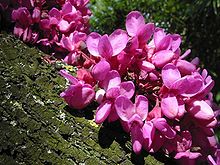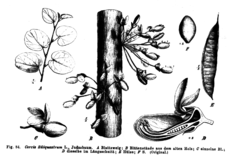- Cercis siliquastrum
-
For other uses, see Judas Tree (disambiguation).
Judas Tree 
Scientific classification Kingdom: Plantae (unranked): Angiosperms (unranked): Eudicots (unranked): Rosids Order: Fabales Family: Fabaceae Genus: Cercis Species: C. siliquastrum Binomial name Cercis siliquastrum
L.Cercis siliquastrum, commonly known as Judas Tree, is a small deciduous tree from Southern Europe and Western Asia which is noted for its prolific display of deep-pink flowers in spring.
Contents
Description
This species forms a small tree up to 12 metres in height and 10 metres in width.[1]
The deep pink flowers are produced on year-old or older growth, including the trunk in late spring (cauliflory). The leaves appear shortly after the first flowers emerge. These are heart-shaped with a blunt apex, which occasionally has a shallow notch at the tip. The tree produces long flat pods that hang vertically.
Taxonomy
The species was first described by Linnaeus in 1753, who gave it the specific epithet of siliquastrum which is derived from the Latin word siliqua, meaning "pod".[2]
Varieties and subspecies include:
- var. hebecarpa Bornm.
- nothosubsp. yaltikirii (Ponert) Govaerts
- var. siliquastrum
- var. alba Weston
Synonyms
Synonyms include:
- Siliquastrum orbicularis Moench
Distribution and ecological aspects
The species is native to Western Asia, including Iran, Iraq, Israel, Jordan, Lebanon and Syria and Southern Europe including Albania, Bulgaria, France, Greece, Italy, Turkey and Former Yugoslavia.[3]
The flowers are pollinated by bees, attracted by nectar. Pollen from the protuding stamens is deposited on the bee's body and carried to another flower's stigma.[4]
Cultivation
The species prefers deep, well-drained soils and a position in full sun or partial shade.[1]
Cultivars include:
- 'Afghan Deep Purple'[5]
- 'Alba' - white flowers[5]
- 'Bodnant'[5]
- 'Carnea'[5]
- 'Fructa Rubra'[5]
- 'Penduliflora'[5]
- 'Rubra' - dark pink-purple flowers
- 'Sterilis'[5]
- 'Variegata'[5]
- 'White Swan'[5]
The tree is susceptible to leafhoppers, scale insects and psyllids (specifically Cacopsylla pulchella) as well as diseases including canker, coral spot and verticillium wilt.
Propagation is by seed, cuttings or budding.
The species produces hard wood with an attractive grain. It is used in veneers and polishes well.[1]
History
There is a longstanding myth that Judas Iscariot hanged himself from a tree of this species. This belief is related to the common name "Judas Tree" which is possibly a corrupted derivation from the French common name, Arbre de Judée meaning tree of Judea, referring to a region where the tree occurs.[6]
Cultural references
- The Judas Tree (Jonathan Creek)
- Flowering Judas by Katherine Anne Porter
- Fictionally used to poison The Doctor in the 2011 episode of Doctor Who, "Let's Kill Hitler"
References
- ^ a b c "Cercis siliquastrum- L.". Plants For A Future. http://www.pfaf.org/user/Plant.aspx?LatinName=Cercis+siliquastrum. Retrieved 13 September2011.
- ^ Rowell, Raymond J. (1980). Ornamental Flowering Trees in Australia. Australia: AH & AW Reed Pty Ltd Reed. ISBN 0-589-50178-X.
- ^ "Taxon: Cercis siliquastrum L.". Germplasm Resources Information Network (GRIN). United States Department of Agriculture, Agricultural Research Service, Beltsville Area. http://www.ars-grin.gov/cgi-bin/npgs/html/taxon.pl?9945. Retrieved 13 September2011.
- ^ Hickey, Michael; Clive King. "100 families of flowering plants". Cambridge University Press. http://books.google.com.au/books?id=LDh7fz9uToMC&pg=PA215&dq=Cercis+siliquastrum+pollination&hl=en&ei=NrluTpXQFa_ImAWp8qzuCQ&sa=X&oi=book_result&ct=result&resnum=5&ved=0CEMQ6AEwBA#v=onepage&q=Cercis%20siliquastrum%20pollination&f=false. Retrieved 13 September 2011.
- ^ a b c d e f g h i Hatch, Laurence (2007). Cultivars of Woody Plants Volume I (A-G). Raleigh, North Carolina: TCR Press. http://books.google.com.au/books?id=Hc8vQI0oM70C&pg=PT489&dq=cercis+siliquastrum&hl=en&ei=JqhuTprZCYeKmQXz5-X-CQ&sa=X&oi=book_result&ct=result&resnum=2&ved=0CDIQ6AEwAQ#v=onepage&q=cercis%20siliquastrum&f=false. Retrieved 13 September 2011.
- ^ Mabberley, D.J. (2008). Mabberleys's plant-book (3 ed.). Cambridge University Press. p. 170. ISBN 9780521820714.
- International Legume Database & Information Service (ILDIS): Cercis siliquastrum
- The Royal Horticultural Society : Circus siliquastrum
- Wildflowers of Israel : Judas tree
Categories:- Cercis
- Flora of Lebanon
Wikimedia Foundation. 2010.





